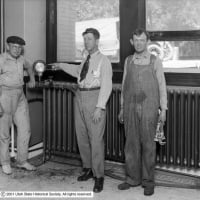Welcome! Here are the website rules, as well as some tips for using this forum.
Need to contact us? Visit https://heatinghelp.com/contact-us/.
Click here to Find a Contractor in your area.
If our community has helped you, please consider making a contribution to support this website. Thanks!
dirty registers
Options
Brad White_9
Member Posts: 2,440
Well, Tim, I did write it for a science teacher like he asked. Guess I went a little overboard. Ooops.
:)
Brad
:)
Brad
0
Comments
-
dirty vent registers
How would you describe to a science teacher why dust would attach itself to the cieling tiles by the register. I believe it has something to do with tatic electricity but I need a good explanation.0 -
Positive charge of the dust particles from friction as they move through the vent, and a grounded register? Opposites attract? I like the static idea, and am pretty sure the friction charges it.
TimJust a guy running some pipes.0 -
Coanda Effect
Airborne ambient dust is the deposited material.
The ceiling register (diffuser) when it releases air at velocity creates a slight negative pressure in the wake of the moving air. (Think of "drafting", being pulled behind an 18-wheeler on the highway as one analogy).
Into this wake is induced room-temperature air, essential for mixing to equilibrium. And with that air, dust.
The initial discharge into the room is cold air at AC temperatures (55F more or less). The immediate effect is a cooling of the ceiling discharge area below the dewpoint of the room. The discharge air also hugs the ceiling, sort of a surface tension effect, the essential part of the Coanda effect.
This causes a field of moisture on the ceiling to which clings airborne dust entrained from ambient room air. It sticks to the ceiling via the moisture.
Notice rooms where smoking is allowed and how much worse it is, to see an extreme example.
To alleviate this, some manufacturers offer "smudge rings", perimeter dropped surfaces that allow the air to travel further away for better mixing before resuming ceiling travel.
Hope this helps.
Brad0 -
What he said...
TJust a guy running some pipes.0 -
thanks
That sounds good. I was also tol dthat the air in the room is a littl emore humid/moist then the discharge air so this causes the dust to stick more due to the static electricity that is made and in the air. It is kind of the same principle as you may find above baseboard heates and such. There is no heat exchanger to worry about due to this i shydro air system. Again, thanks for the help.
Joe0 -
Similar principles
Static electricity is quite probably a factor but a relatively small one compared to the moving force of air. Key is, what are the respective charges of the particles and is the ceiling negative and the particles positive, all that. Definitely a factor for if the particles repelled the effect would be less. Still present but less to what degree I do not know.
The "Baseboard Streaking" phenomenon (not to be confused with your Slant-Fin or Argo running naked down the street) is also similar in origin.
Ever been in an old church where you can "read" the lath, plaster and stud lines in dust on the wall above a radiator?
That is due to the colder surfaces harboring slight moisture giving adhesion to the convective dust rising from the radiator. Same church, different pew as one might say 0
0
This discussion has been closed.
Categories
- All Categories
- 87.3K THE MAIN WALL
- 3.2K A-C, Heat Pumps & Refrigeration
- 61 Biomass
- 428 Carbon Monoxide Awareness
- 120 Chimneys & Flues
- 2.1K Domestic Hot Water
- 5.8K Gas Heating
- 114 Geothermal
- 166 Indoor-Air Quality
- 3.7K Oil Heating
- 77 Pipe Deterioration
- 1K Plumbing
- 6.5K Radiant Heating
- 395 Solar
- 15.7K Strictly Steam
- 3.4K Thermostats and Controls
- 56 Water Quality
- 51 Industry Classes
- 50 Job Opportunities
- 18 Recall Announcements
